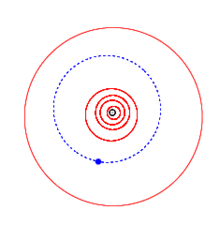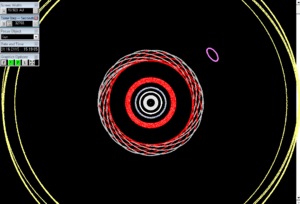- 10 Hygiea
-
10 Hygiea  Discovery
DiscoveryDiscovered by A. de Gasparis Discovery date April 12, 1849 DesignationsPronunciation /haɪˈdʒiːə/ hy-jee-ə, or as Greek: ‘Υγιεία Named after Hygieia Alternate name(s) none Minor planet
categoryMain belt (Hygiea family) Adjective Hygiean Epoch November 30, 2008 (JD 2454800.5) Aphelion 3.507 AU
(524.63 Gm) (Q)Perihelion 2.770 AU
(414.38 Gm) (q)Semi-major axis 3.139 AU
(469.58 Gm)Eccentricity 0.117 Orbital period 5.56 yr
(2031.01 d)Average orbital speed 16.76 km/s Mean anomaly 197.96° (M) Inclination 3.842° Longitude of ascending node 283.45° Argument of perihelion 313.19° Proper semi-major axis 3.1417827 AU Proper eccentricity 0.1356315 Proper inclination 5.1039060° Proper mean motion 64.621768 deg/yr Proper orbital period 5.57088 yr
(2034.763 d)Precession of perihelion 128.543611 arcsec/yr Precession of the ascending node −96.902395 arcsec/yr Physical characteristicsDimensions 530×407×370 ±7 km[2]
431 km (mean)Surface area 837,080.744 km2 (323,198.682 sq mi) Mass (86.7±1.5)×1018 kg[2] Mean density 2.08 ± 0.10 g/cm³[2] Equatorial surface gravity 0.091 m/s² Escape velocity 0.21 km/s Rotation period 27.623 h[1] Albedo 0.0717 (geometric)[1] Temperature ~164 K
max: 247 K (−26° C) [4]Spectral type C-type asteroid[1] Apparent magnitude 9.0[5] to 11.97 Absolute magnitude (H) 5.43[1] Angular diameter 0.318" to 0.133" 10 Hygiea is an asteroid located in the asteroid belt. With somewhat oblong diameters of 350–500 km, and a mass estimated to be 2.9% of the total mass of the belt,[6] it is the fourth largest asteroid by volume and mass. It is the largest of the class of dark C-type asteroids with a carbonaceous surface.
Despite its size, due to its dark surface and larger-than-average distance from the Sun, it appears very dim when observed from Earth. For this reason several smaller asteroids were observed before Annibale de Gasparis discovered Hygiea on April 12, 1849. At most oppositions, Hygiea has a magnitude that is four orders lower than Vesta's, and observing it will require at least a 100 mm (4-inch) telescope, while at a perihelic opposition, it may be observable with 10x50 binoculars.
Contents
Discovery and name
Hygiea was discovered by Annibale de Gasparis on April 12, 1849, in Naples, Italy.[8] It was the first of his nine asteroid discoveries. The director of the Naples observatory, Ernesto Capocci, named the asteroid. He chose to call it Igea Borbonica ("Bourbon Hygieia") in honor of the ruling family of the Kingdom of the Two Sicilies where Naples was located.[9]
However, in 1852, John Russell Hind wrote that "it is universally termed Hygeia, the unnecessary appendage 'Borbonica' being dropped."[9] The name comes from Hygieia, the Greek goddess of health, daughter of Asclepius (Aesculapius for the Romans).[10] The name was often spelled Hygeia in the nineteenth century, for example in the Monthly Notices of the Royal Astronomical Society.[11]
Physical characteristics
 Sizes of the first 10 asteroids discovered profiled against Earth's Moon. Hygiea is furthest right.
Sizes of the first 10 asteroids discovered profiled against Earth's Moon. Hygiea is furthest right.
Hygiea's surface is composed of primitive carbonaceous material similar to the chondrite meteorites. Aqueous alteration products have been detected on its surface, which could indicate the presence of water ice in the past which was heated sufficiently to melt.[10] The primitive present surface composition would indicate that Hygiea had not been melted during the early period of Solar system formation,[10] in contrast to other large planetesimals like 4 Vesta.
It is the main member of the Hygiea family and contains almost all the mass in this family (well over 90%). It is the largest of the class of dark C-type asteroids with a carbonaceous surface that are dominant in the outer asteroid belt—which lie beyond the Kirkwood gap at 2.82 AU. Hygiea appears to have a noticeably oblate spheroid shape, with an average diameter of 444 ± 35 km and a semimajor axis ratio of 1.11.[10] This is much more than for the other objects in the "big four"—the dwarf planet Ceres and the asteroids 2 Pallas and 4 Vesta. Aside from being the smallest of the four, Hygiea, like Ceres, has a relatively low density, which is more comparable to the icy satellites of Jupiter or Saturn than to the terrestrial planets or the stony asteroids.
While it is the largest body in its region, due to its dark surface and larger-than-average distance from the Sun it appears very dim when observed from Earth. In fact, it is the third dimmest of the first twenty-three asteroids discovered, only 13 Egeria and 17 Thetis having lower mean opposition magnitudes.[12] At most oppositions, Hygiea has a magnitude of around +10.2,[12] which is as much as four orders fainter than Vesta, and will require at least a 4-inch (100 mm) telescope to resolve.[13] At a perihelic opposition, however, Hygiea can reach +9.1 and may just be resolvable with 10x50 binoculars, unlike the next two largest asteroids in the asteroid belt, 704 Interamnia and 511 Davida, which are always beyond binocular visibility.
At least 5 stellar occultations by Hygiea were tracked by Earth-based observers,[14] but all with few observing independent measurements so that much was not learned of its shape. The Hubble Space Telescope was able to resolve the asteroid, and to rule out the presence of any orbiting companions larger than about 16 km in diameter.[15]
Orbit and rotation
Generally Hygiea's properties are the most poorly known out of the "big four" objects in the asteroid belt. Its orbit is much closer to the plane of the ecliptic than those of Ceres, Pallas or Interamnia,[10] but is less circular than Ceres or Vesta with an eccentricity of around 12%.[1] Its perihelion is at a quite similar longitude to those of Vesta and Ceres, though its ascending and descending nodes are opposite to the corresponding ones for those objects. Although its perihelion is extremely close to the mean distance of Ceres and Pallas, a collision between Hygiea and its larger companions is impossible because at that distance they are always on opposite sides of the ecliptic. Though in 2056, Hygiea will pass 0.025AU from Ceres, and then in 2063, Hygiea will pass 0.020AU from Pallas.[16] At aphelion Hygiea reaches out to the extreme edge of the asteroid belt at the perihelia of the Hilda family which is in 3:2 resonance with Jupiter.[17]
It is an unusually slow rotator, taking 27 hours and 37 minutes for a revolution,[1] whereas 6 to 12 hours are more typical for large asteroids. Its direction of rotation is not certain at present, due to a twofold ambiguity in lightcurve data that is exacerbated by its long rotation period—which makes single-night telescope observations span at best only a fraction of a full rotation—but it is believed to be retrograde.[10] Lightcurve analysis indicates that Hygiea's pole points towards either ecliptic coordinates (β, λ) = (30°, 115°) or (30°, 300°) with a 10° uncertainty.[18] This gives an axial tilt of about 60° in both cases.
References
- ^ a b c d e f g "JPL Small-Body Database Browser: 10 Hygiea". http://ssd.jpl.nasa.gov/sbdb.cgi?sstr=10. Retrieved 2008-09-07.
- ^ a b c Jim Baer (2010). "Recent Asteroid Mass Determinations". Personal Website. http://home.earthlink.net/~jimbaer1/astmass.txt. Retrieved 2011-09-02.
- ^ "AstDyS-2 Hygiea Synthetic Proper Orbital Elements". Department of Mathematics, University of Pisa, Italy. http://hamilton.dm.unipi.it/astdys/index.php?pc=1.1.6&n=10. Retrieved 2011-10-01.
- ^ L.F. Lim; McConnochie, T; Belliii, J; Hayward, T (2005). "Thermal infrared (8–13 µm) spectra of 29 asteroids: the Cornell Mid-Infrared Asteroid Spectroscopy (MIDAS) Survey". Icarus 173 (2): 385. Bibcode 2005Icar..173..385L. doi:10.1016/j.icarus.2004.08.005.
- ^ "AstDys (10) Hygiea Ephemerides". Department of Mathematics, University of Pisa, Italy. http://hamilton.dm.unipi.it/astdys/index.php?pc=1.1.3.1&n=10&oc=500&y0=2095&m0=6&d0=27&h0=00&mi0=00&y1=2095&m1=6&d1=28&h1=00&mi1=00&ti=1.0&tiu=days. Retrieved 2010-06-26.
- ^ "Mass of 10 Hygiea" 0.445 / "Mass of Mbelt" 15 = 0.0296
- ^ O. Gingerich (2006). "The Path to Defining Planets" (PDF). Harvard-Smithsonian Center for Astrophysics and IAU EC Planet Definition Committee chair. http://astro.cas.cz/nuncius/nsiii_03.pdf. Retrieved 2007-03-13.
- ^ A. O. Leuschner (1922-07-15). "Comparison of Theory with Observation for the Minor planets 10 Hygiea and 175 Andromache with Respect to Perturbations by Jupiter". Proceedings of the National Academy of Sciences of the United States of America (National Academy of Sciences) 8 (7): 170–173. Bibcode 1922PNAS....8..170L. doi:10.1073/pnas.8.7.170. PMC 1085085. PMID 16586868. http://www.pubmedcentral.nih.gov/articlerender.fcgi?tool=pmcentrez&artid=1085085.
- ^ a b John Russell Hind (1852). The Solar System: Descriptive Treatise Upon the Sun, Moon, and Planets, Including an Account of All the Recent Discoveries. G. P. Putnam. p. 126.
- ^ a b c d e f Barucci, M (2002). "10 Hygiea: ISO Infrared Observations". Icarus 156 (1): 202. Bibcode 2002Icar..156..202B. doi:10.1006/icar.2001.6775.
- ^ Hartnup, J. (June 1850). "Observations of Hygeia". Monthly Notices of the Royal Astronomical Society 10: 162. Bibcode 1850MNRAS..10..162H.
- ^ a b Moh'd Odeh. "The Brightest Asteroids". The Jordanian Astronomical Society. http://jas.org.jo/ast.html. Retrieved 2008-05-21.
- ^ "What Can I See Through My Scope?". Ballauer Observatory. 2004. http://www.allaboutastro.com/Articlepages/whatcanisee.html. Retrieved 2008-07-20.
- ^ James L. Hilton. "Asteroid Masses and Densities" (PDF). U.S. Naval Observatory. Lunar and Planetar Institute. http://www.lpi.usra.edu/books/AsteroidsIII/pdf/3008.pdf. Retrieved 2008-08-26.
- ^ A. Storrs (1999). "Imaging Observations of Asteroids with Hubble Space Telescope". Icarus 137 (2): 260. Bibcode 1999Icar..137..260S. doi:10.1006/icar.1999.6047.
- ^ "JPL Close-Approach Data: 10 Hygiea". 2009-11-27 last obs. http://ssd.jpl.nasa.gov/sbdb.cgi?sstr=10;cad=1#cad. Retrieved 2010-03-02.
- ^ L’vov V.N., Smekhacheva R.I., Smirnov S.S., Tsekmejster S.D.. "Some Peculiarities in the Hildas' Motion" (PDF). Central (Pulkovo) Astronomical Observatory of Russian Academy of Sciences. http://neopage.nm.ru/ENG/GENERAL/DATA/hil-a.pdf. Retrieved 2008-09-07.
- ^ M. Kaasalainen (2002). "Models of Twenty Asteroids from Photometric Data" (PDF). Icarus 159 (2): 369. Bibcode 2002Icar..159..369K. doi:10.1006/icar.2002.6907. http://www.rni.helsinki.fi/~mjk/IcarPIII.pdf. Retrieved 2009-06-23.
External links
- Shape model deduced from lightcurve
- A simulation of the orbit of Hygiea
- Asteroid Database—Detailed View—10 Hygiea
- Yeomans, Donald K.. "Horizons system". NASA JPL. http://ssd.jpl.nasa.gov/?horizons. Retrieved 2007-03-20. — Horizons can be used to obtain a current ephemeris.
- "Elements and Ephemeris for (10) Hygiea". Minor Planet Center. http://scully.cfa.harvard.edu/cgi-bin/returnprepeph.cgi?d=b2011&o=00010. (displays Elong from Sun and V mag for 2011)
Minor planets navigator Small Solar System bodies Minor planets - Designation
- Groups
- Moons
- Meanings of names
- Pronunciation of names
Comets Meteoroids Lists / categories - Asteroid groups and families
- Asteroid moons
- Binary asteroids
- Minor planets
Categories:- Hygiea asteroids
- Asteroids named from Greek mythology
- C-type asteroids
- Dwarf planet candidates
- 1840s in science
- Astronomical objects discovered in 1849
Wikimedia Foundation. 2010.



